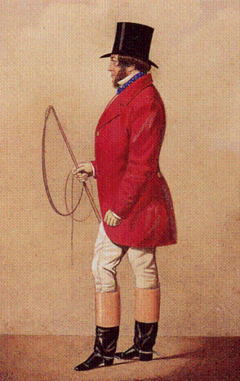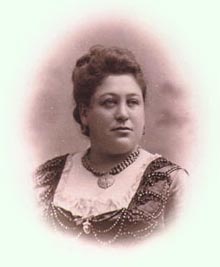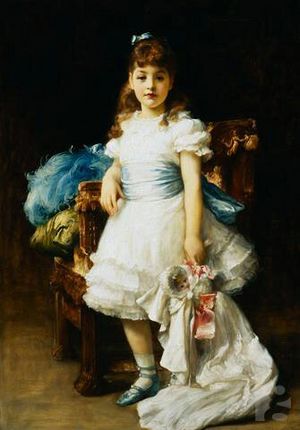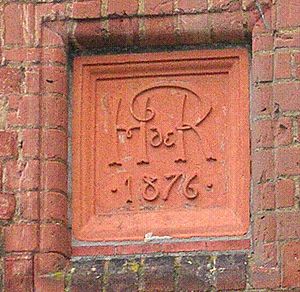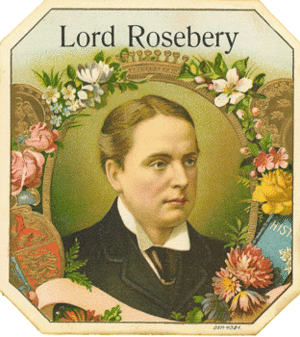Hannah Primrose, Countess of Rosebery facts for kids

Hannah Primrose, Countess of Rosebery (born Hannah de Rothschild; 27 July 1851 – 19 November 1890) was the daughter of Baron Mayer de Rothschild. When her father passed away in 1874, she became the richest woman in Britain.
In 1878, Hannah de Rothschild married Archibald Primrose, 5th Earl of Rosebery. After her marriage, she was known as the Countess of Rosebery. Her husband was a very famous and important politician in Britain. Hannah was a big support for him. She also did a lot of charity work, especially helping working-class Jewish women in London. She died suddenly in 1890, when she was only 39 years old.
Contents
Early Life
Hannah de Rothschild was born in 1851 into a world of incredible wealth. Her grandfather, Baron Nathan Mayer Rothschild, had started the English part of the famous Rothschild banking family. By the mid-1800s, the Rothschilds were so rich and powerful that they were almost like a royal family among the Jews of Europe. Their homes and art collections in England and other countries were as grand as those of actual kings and queens. One of their homes, Mentmore, had one of the best art collections in the world.
Hannah's father, Baron Meyer Amschel de Rothschild, married his cousin Juliana Cohen in 1850. This marriage inspired him to build a huge country house called Mentmore. Hannah, who was only five months old, even helped lay the first stone for the house on 31 December 1851.
Many of Hannah's relatives also built large homes nearby, creating a private world of luxury and safety for her. Besides Mentmore, her parents had a big house in London and a fancy yacht called The Zenaide.
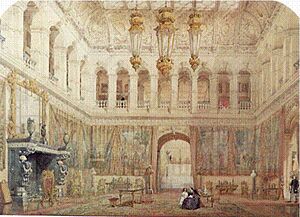
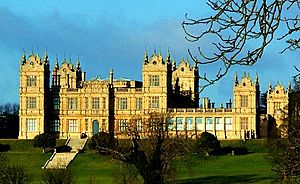
Hannah was an only child, and her childhood was quite lonely, even though she lived in palaces. She spent a lot of time with her mother, who was often sick. Hannah's parents were very protective and didn't want her to see any sickness or poverty. She was never allowed to go inside the small houses on their estates.
Despite her sheltered life, Hannah was very confident. When she was only 17, she hosted a big party at Mentmore for the Prince of Wales and impressed everyone with her poise. A year later, in 1869, she was formally introduced to society at Buckingham Palace by her mother, meeting Queen Victoria.
When her father, Mayer Amschel de Rothschild, died in 1874, Hannah inherited Mentmore (with its priceless art collection), his London house, and a huge amount of money. This made her the wealthiest woman in England.
Marriage to Lord Rosebery
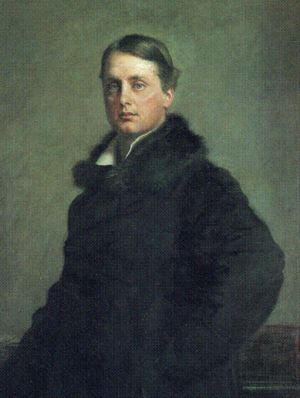
Hannah de Rothschild first met her future husband, Archibald, the 28-year-old Earl of Rosebery, at a horse race. He was a very handsome and cultured man. He had inherited his title and a large income from his grandfather in 1868. He also owned a lot of land in Scotland and England.
Their marriage was quite a big deal at the time because Hannah was Jewish and Archibald was Christian. Even though the Rothschilds were accepted in society and were friends with some members of the royal family, there were still some people who had negative feelings towards Jewish people. Queen Victoria herself had said she didn't want to make a Jewish person a peer.
Rosebery's own mother was not happy about him marrying a Jewish woman. Hannah was also very dedicated to her Jewish faith, and it was a difficult decision for her to marry outside of it. The Rothschild family usually married cousins to keep their wealth within the family. The Jewish Chronicle newspaper even expressed sadness about the marriage, seeing it as a threat to Jewish traditions.
Despite these challenges, their engagement was announced on 3 January 1878. Rosebery described Hannah as "very simple, very unspoilt, very clever, very warm-hearted and very shy." They were married in London on 20 March 1878. The Prince of Wales and Benjamin Disraeli (a former Prime Minister) were among the guests.
Life as Countess of Rosebery
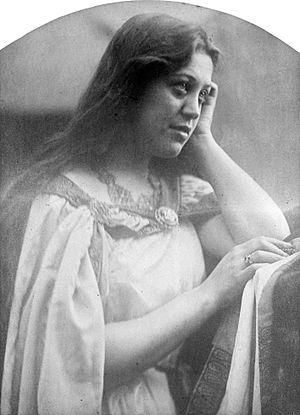
After their marriage, the Roseberys lived in London in the house Hannah had inherited from her father. As their social and political lives grew, they leased a larger home called Lansdowne House. This grand house became a famous meeting place for important politicians, social leaders, royalty, and writers like Henry James and Oscar Wilde.
The Roseberys spent their year moving between their different homes. They were in London for the social season and when Parliament was meeting. They went to Mentmore on weekends to host parties for politicians and for hunting. In August, they would move to Dalmeny, Rosebery's Scottish home, for grouse shooting. They also had a smaller home called "The Durdans" in Epsom, where they spent time, especially during the famous Epsom Derby horse race.
The Earl and Countess of Rosebery greatly added to their art collections at Mentmore and Dalmeny. They collected many rare books and items that once belonged to Emperor Napoleon I.
Their Relationship
Many people who wrote about the Roseberys said they had a happy marriage. Hannah seemed very happy and devoted to her husband. She was always eager to help him in any way she could.
Rosebery was a complex person. He could be moody and reserved. Hannah, on the other hand, was very loving and supportive. She was often the one who encouraged him and helped him deal with the outside world. She was the strong force in their relationship, keeping him grounded.
Rosebery sometimes behaved in unusual ways. He decided to fix up a small ruined castle called Barnbougle Castle, near Dalmeny House. After it was finished in 1882, he started spending his nights there alone, saying the quiet waters helped him sleep.
The Roseberys traveled a lot, often without their children. In 1883, they left their children with nannies and went on a long trip to America and Australia. Hannah owned large investments in North America, including ranches in Texas and mines in Montana. Their arrival in New York was widely reported in newspapers. Hannah enjoyed California, noting how the women there were very fashionable and often divorced.
Hannah was very devoted to her husband. She once told him, "I sometimes think it is wrong that I have thought less of the children in comparison to you." This shows how much she focused on him. However, it also suggests she knew she was making a choice that affected her children.
It was common for upper-class mothers in the 19th century to have many nannies and governesses for their children. So, Hannah's way of raising her children was typical for her time. Despite their long trips away, the Roseberys were not completely distant from their children. Rosebery himself enjoyed playing with them on the floor.
Their Children
Hannah and Archibald had four children:
- Lady Sybil Primrose, born in 1879.
- Lady Margaret Primrose, born in 1881.
- Harry Primrose, Lord Dalmeny (who later became the 6th Earl of Rosebery), born in 1882.
- The Honourable Neil Primrose, also born in 1882.
Politics and Influence
Hannah de Rothschild grew up with good common sense and confidence, which helped her become a perfect political wife. Her marriage to Rosebery changed his status too. He became a very wealthy and glamorous figure, which appealed to the public.
From the start of their marriage, the Rothschild family, who were involved in politics, took an interest in Rosebery. He quickly became seen as a rising star in the Liberal Party. Rosebery was very smart, but he could also be lazy and get bored easily. Some people thought Hannah was more ambitious than him. Lord Granville even told her, "If you keep him up to the mark, [he] is sure to have his page in history." Hannah's main goal became helping her husband achieve his place in history.
Rosebery was not a natural politician. He disliked the arguments and fights of politics. However, he was a very good speaker, which was important at a time when public speaking was becoming more popular.
The Midlothian Campaign
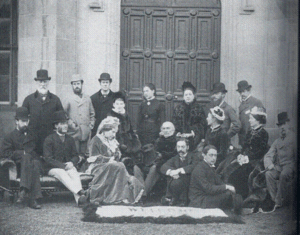
Hannah's political skills were first clearly seen during the campaign to re-elect Gladstone in 1880. This campaign, known as the Midlothian campaign, was planned by the Roseberys. Rosebery used his influence to get Gladstone to run for Parliament in Midlothian, which was near Rosebery's Dalmeny estate.
The campaign was based at Dalmeny, where Lady Rosebery hosted many large political parties. The Roseberys would travel with Gladstone and other speakers to towns and cities across Scotland. They often spoke to huge crowds from a special train car. These events were like big festivals.
Gladstone was supported not only by the popular Rosebery but also by well-dressed women like Lady Rosebery and Gladstone's daughter. These fashionable people were like celebrities and drew huge crowds. Lady Rosebery wrote that she was proud to see her husband speak. Thanks to Rosebery's planning, Gladstone won the election and became Prime Minister again. It was clear that Lady Rosebery was a very valuable asset in politics.
Supporting Rosebery's Career
Hannah's political determination and her ambitions for her husband were tested during Gladstone's second government. Rosebery was offered a government job, but he turned it down because he felt it wasn't important enough. He also said he was feeling unwell. Political leaders urged Lady Rosebery to convince him, but she defended his decision.
Lady Rosebery kept trying to get Gladstone to give her husband a higher position in the government. She even befriended other politicians who supported her husband. Finally, in 1881, Rosebery was offered a job he liked: Under Secretary at the Home Office with special responsibility for Scotland.
However, Rosebery immediately started asking for a place in the cabinet, which is a group of the most important government ministers. Gladstone refused because Rosebery was too new to government. Lady Rosebery, believing in her husband's great ability, pushed him to get what he wanted. She even had an argument with Gladstone's wife.
Rosebery eventually resigned from the government. Lady Rosebery then tried a new approach. She spoke to Lord Hartington, a very influential politician, for three hours on a train, arguing for her husband's case. When they returned from a long trip to America and Australia in 1885, Rosebery was finally given the important position he wanted in the cabinet.
Charity Work
Like many wealthy women of her time, Lady Rosebery supported many charities. One of her first actions after inheriting her fortune was to fund a lifeboat station in memory of her father in 1875.
Her main charity work focused on helping women. She was president of the Scottish Home Industries Association, which helped Scottish women earn money by working from home, making things like plaid fabrics or needlework. This allowed women, especially mothers who had lost their husbands, to care for their families while still earning an income.
Queen Victoria appointed her president of the Queen Victoria Jubilee Institute for Nurses in Scotland. This was the start of the district nurse system, which greatly improved health care for poor and sick people in rural areas of Britain. She also worked to improve nursing standards in general.
Like many of her Rothschild relatives, she was deeply involved in helping young working-class Jewish women in poorer parts of London, especially in Whitechapel. There, she founded the Club for Jewish Working Girls. She also gave money to many other Jewish charities.
Her interest in education is one of her most lasting charity legacies. She founded schools in all the villages around the Roseberys' estates. For example, she built three schools at Wingrave, Cheddington, and Mentmore. She paid for trained teachers and even provided the children with new clothes each season. Cheddington School still exists in its original building with her special symbol on its walls.
Death
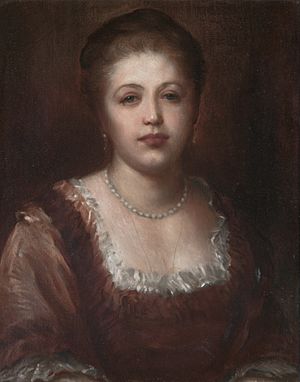
Lady Rosebery died from typhoid fever at Dalmeny in 1890. Doctors later found that she also had a kidney condition called Bright's disease, which had weakened her. She was buried according to Jewish traditions. Rosebery found her death very difficult. He wrote to Queen Victoria about his pain. Doctors told him that her kidney condition would have caused her death within two years anyway.
Her funeral was held on 25 November 1890 at Willesden Jewish Cemetery.
Legacy
There is no doubt that Hannah helped her husband a lot in his political career. She seemed to enjoy seeing him achieve the high positions she felt he deserved. She also helped to balance his more extreme ideas.
After his wife's death, Rosebery stopped being involved in politics for a while. He wrote in 1891, "The sole object of my ambition has disappeared with the death of my wife." Queen Victoria also believed that Lady Rosebery was the stable part of their partnership. She thought that Rosebery's behavior changed after his wife's death because "poor Lady Rosebery is not there to keep him back."
Queen Victoria had liked Lady Rosebery very much and sent Rosebery several letters of sympathy. She even compared his loss to the death of her own husband, Prince Albert.
After his wife's death, Rosebery went on a trip to Spain. When he returned, he designed a small, beautiful tomb for his wife, like a miniature Taj Mahal. For the rest of his life, he wore black clothes and used black-edged writing paper to show his sadness.
Winston Churchill later said that Rosebery was deeply affected by her death. He believed that Hannah was a remarkable woman who supported Rosebery, and he was never able to find that kind of support again.
Children's Later Lives
Lady Rosebery's eldest son, Harry, became captain of the Surrey County Cricket Club and owned two horses that won the Epsom Derby. He later became the 6th Earl of Rosebery and died in 1974.
Her daughter Margaret married her father's old friend and biographer, the Marquess of Crewe. Their wedding in 1899 was so famous that it stopped traffic in London. Lady Crewe became one of the first women magistrates in Britain. She died in 1955.
Lady Sybil, another daughter, was known for being quite unique and spent much of her time living in a caravan.
Neil, the Roseberys' second son, entered politics and was expected to have a promising future. However, he joined the army when World War I started and was killed in battle in 1917.
Properties
Of Hannah Rosebery's homes, the lease on Lansdowne House was given up shortly before her death. The Roseberys bought a new house at 38 Berkeley Square, which became one of London's most luxurious homes. However, Lady Rosebery did not live to see it finished.
Mentmore, the grandest of the Roseberys' homes, was sold by Lady Rosebery's grandson in 1977, along with the famous Rothschild art collection. Lady Rosebery had been very interested in this collection and had added to it. She even wrote a catalog for it, saying, "In time to come, when, like all collections, this will be dispersed (and I hope this will be long after my death) this book may be of value."
A few pieces of furniture and paintings from Mentmore were moved to Dalmeny, which is the only house that remains in the family today. Three paintings were bought for the National Gallery. The rest of the collection was sold and is now spread across the world.
Town Named After Her
Pardes Hanna (meaning "Hannah's [Citrus] Orchard" in Hebrew), a town founded in 1929 in Israel, was named after Hannah Primrose, Countess of Rosebery.
In Literature
Lady Rosebery is believed to be the inspiration for a character named Marcella Maxwell in the novel Sir George Tressady (1909) by Mrs Humphry Ward. The author lived near Lady Rosebery's home at Mentmore.
Images for kids
-
Hannah Rosebery's sarcophagus at Willesden Jewish Cemetery. The tomb’s enclosing mausoleum was destroyed by German bombing in 1941.


